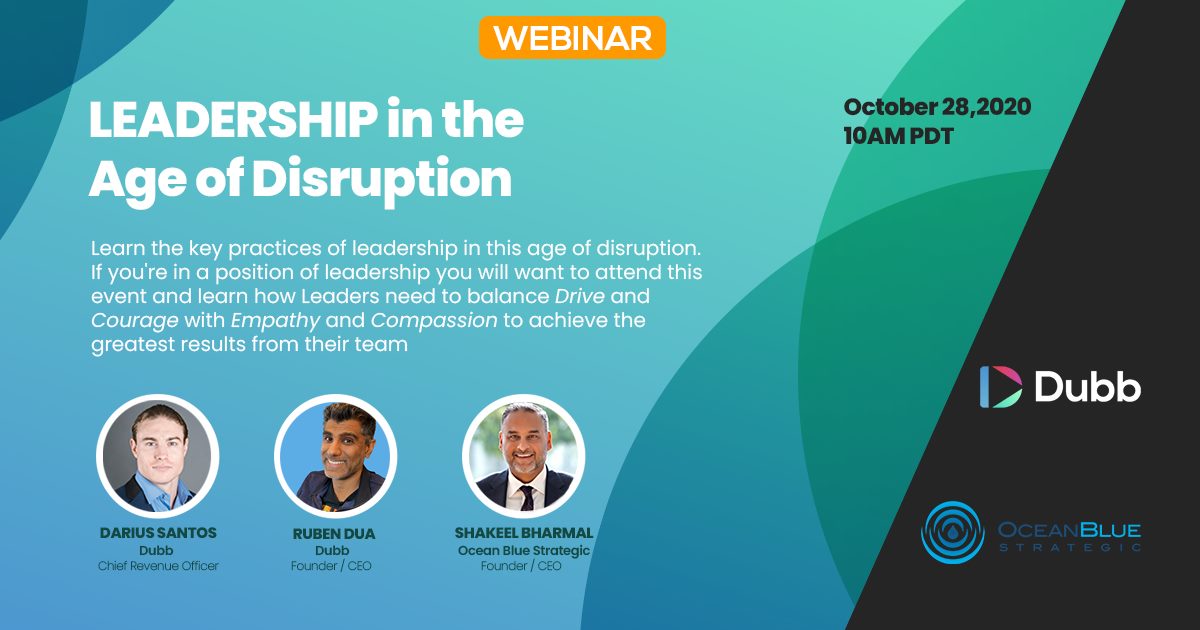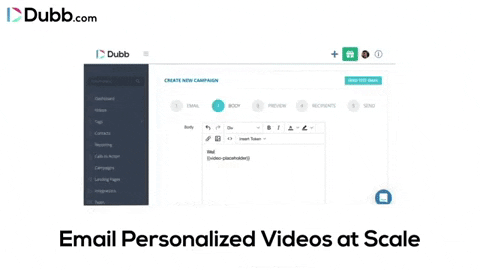Do any of these sound familiar? 📢📢📢
✓ I want to help my team more quickly reach its goals.
✓ I need help in leading my team in a remote-first world
✓ I’m struggling to inspire my team amidst so much uncertainty.
✓ I was just thrust into a leadership role and need to quickly develop my leadership skills.
✓ I’m interested in preparing myself to become a future leader in my organization.
If so, check out this webinar on practical leadership skills in an era of disruption. Dubb’s CEO/Founder ⭐️ Ruben Dua, Chief Revenue Officer Darius Santos, and Ocean Blue Strategic Founder Shakeel Bharmal will share some actionable insights on how you can lead your team to your goals.
Navigating disruption has to be one of the most challenging jobs to do as a leader. Even when disruptions seem minor, they could still take a toll on both employers and employees. It also doesn’t matter if they’re short-lived, because they continuously come at us from left, right, and center.
Leadership, in and of itself, is already an incredibly challenging role to handle. When a disruptive force presents itself but our leadership isn’t built on solid foundations, we will surely suffer.
Disruptive forces come in many shapes and forms. They don’t only affect industries as a whole, but they also bring about extreme challenges for both employers and employees.
Take the fact that the workplace is becoming increasingly multigenerational, for example. To effectively create an inclusive and productive work environment, managers must learn to understand their employees’ diverse backgrounds and cultures. From the employees’ perspective, they might have a hard time cooperating because of differences.
Another disruptive factor for any industry is technology. It’s almost as if each day, a new technology emerges. For companies to continue to thrive, maintain their competitive edge, and keep up with the times, it’s vital to continue incorporating innovative technologies. While constant technological advancement does offer tremendous opportunities, it’s still quite difficult to adapt and adjust to the fundamental changes that it has on the way we conduct business.
Besides these, there are many other disruptive factors affecting businesses. Some of the most prevalent are contemporary social issues, changes in demographic trends, sudden economic shifts, and globalization.
Because of the rapid and frequent changes that these forces compel workplaces to undergo, we need leaders who are beyond capable of operating under pressure, effecting positive change and impact, navigating uncertainty, and, despite the odds, motivating employee productivity. But more than the skills and competencies required to run a business afloat, these unsettling situations also call for compassion and empathy.
For these exact reasons, we invited Shakeel Bharmal to speak at one of Dubb’s training webinars. Shakeel is the founder and CEO of OceanBlue Strategic, a professional training and coaching firm established to empower individuals and teams to thrive amidst disruption and make a lasting impact in their communities and organizations.
Shakeel provided valuable insight about leading in times of disruption and uncertainty. He firmly believes that no matter which industry you belong to, how large or small the team you’re leading, or if you only consider yourself as someone in a position of influence, leadership is the greatest public service.
Leaders aren’t merely supposed to take followers from one place to another. They’re not only people with exceptional qualities that were evident enough for someone to consider appointing them a title. You see, the most powerful and influential leaders are in a position to create a lasting impact. This impact can stem from how they have helped others, the values they hold and pass on, and the characteristics they exhibit. Whatever a leader does, it creates a positive impact. At least, it’s supposed to.
Either way, leaders have a significant influence on the people around them. Every action they commit and every word they say affects others in ways unimaginable. It’s primarily the reason why Shakeel describes leading as dropping a pebble in the middle of the water, and its impact as similar to the ripples made. Each wave produced by every pebble makes small but significant shifts in the water, which can potentially cause far-reaching change. As leaders create waves within the people around them, those people produce waves within others around them, and to those around them, and so on.
But we live in a disruptive world. There’s too much volatility present that the waters could not remain still. And if the waters aren’t calm, then making ripples is just about impossible.
There’s an acronym that describes the world we are in: VUCA. It’s a concept put together by students from the U.S. Army War College to characterize the state of the world in the aftermath of the Cold War. The term VUCA reflects volatility, uncertainty, complexity, and ambiguity. The nature of the world that we now live in is brimming with VUCA. At present, its relevance has begun to extend to principles in connection with leadership.
- Volatility denotes that change is always happening, and it’s happening at breakneck speed. Anything can be subject to constant, rapid, and significant change.
- Uncertainty means that not all outcomes of the decisions we make are clear. The world has large elements of unpredictability.
- Complexity conveys that there are always several factors to take into consideration that it’s tough to get to the root of an issue, let alone come to rational judgments.
- Ambiguity indicates a lack of clarity that results from either an abundance or a scarcity of information. There’s too much or too little information available, making it hard to make sense of anything.
We live in a world of VUCA. It might sound a bit strange to say out loud, but it’s our reality, and we have to figure out how to navigate it.
And so, we are left to ponder the question of how do we manage a reality that’s too volatile, uncertain, complex, and ambiguous?
The truth of the matter is that only 18% of leaders are capable of leading in a VUCA world. Why? It’s because our education systems and the way our parents raise us do not prepare nor supply us the skill sets necessary to navigate these fast-changing, unpredictable, complex, and ambiguous times. Nonetheless, there’s still hope. We can develop the skills needed for leading in spite of disruption. Just as the world keeps shifting and turning, humans are continually evolving and learning—part of gearing up for disruption is acknowledging this fact and taking in this mindset.
In view of these realities, Shakeel equipped us with the practices, behaviors, and attitudes we need to adapt as leaders in a disruptive world.
Leadership for a VUCA World
Growth Mindset
Having a growth mindset means recognizing that you’re able to learn, unlearn, and relearn things. It’s carrying a perspective and attitude that only because something happened in a particular way in the past doesn’t necessarily mean that it will turn out the exact same way in the future.
If you were successful in the past in committing to a particular action, you shouldn’t expect it to play out successfully again later on.
Turning it around, if you’ve gone through failing at something before, it doesn’t mean that it was a waste of your time, effort, or energy. A growth mindset says that you view it as an opportunity to learn something and to improve how you would approach it in the future.

But you see, a growth mindset is not only an idea that you individually carry to continue to grow in leadership. Possessing a growth mindset is something that you ultimately demonstrate. It involves constant awareness that you are learning new things, unlearning the old that might have worked before but probably wouldn’t tomorrow, and relearning things anew, every single day, and setting that example for your people to follow.
In essence, a growth mindset means understanding that you are continually growing and developing your leadership qualities through practice and experience.
Customer-Centric Design
A customer-centric design means approaching products and services design with the consumers’ needs, wants, and best interests in mind.

We hear about this concept nearly every time from business people, but the question is, do we practice it? How much do we understand the weight of putting our customers first?
We often go through life looking out for our own interests, then attempting to persuade other people to want the same things. We tend to make it our sole mission to sell, sell, sell, only thinking about what we want. But that’s not what being customer-centric means. Functioning based on a customer-centric design means paying attention to your customers’ needs, wants, and determining what happens in their lives in order to meet them right where they are.
Putting your customers first entails anticipating how their lives could change in the future and then working backward to see what you can bring to the table. This doesn’t only have to do with improving material elements of your products, but ultimately providing help through your skills and capabilities as a leader.
It also means not settling for what has already worked. People’s needs are always changing with the times. Customer-centric thinking involves gathering all possible information about their problems, what they need, and working time and time again to actively present answers and solutions.
Business Acumen

Developing business acumen might sound like an obvious task to do as a leader. But in times of severe disruption, it’s easy to get distracted by new trends and technologies. When that happens, we tend to lose sight of our primary goals, which is mainly the return on the investment we’re making—time, money, attention, and energy. Business acumen suggests that we always hold clear expectations on the financial returns and impact of our efforts. It’s impossible to create a sustainable organization without a clear view of how we are managing the company’s financial assets—we’d only be spinning our wheels.
Self-Reflection
Maintaining a habit of reflecting on the things you do and the decisions you make is crucial. Ponder about everything in the moment and after the moment.
What could you have done better? What are the lessons you’ve taken away from this particular experience? What steps will you take tomorrow? Are the goals you’ve set constructive or destructive? Are you surrounding yourself with the right people? Are you delivering the right message?

In self-reflecting, you have to ask yourself even the toughest questions. Self-reflecting is essential for your development as an individual, but it also helps you identify which business methods might need changing and what new systems need implementation.
Empathetic Communication
Shakeel describes empathetic communication as “working with an open heart.” As said before, we need competency in leadership. But we also need compassion.

Some might take seasons of disruption as opportunities to innovate and spark creativity among the workforce. But for most, these are times of anxiety, difficulty, and change. No matter how big or how small, change can be difficult. As a leader, you must be capable of recognizing the reality that some of your employees might be struggling to manage these significant changes and disruptions.
A great leader is able to empathize. Note that we said empathize, not sympathize. Sympathizing means feeling sorry for your people; empathizing means understanding that even though you might already have your eyes set on the future, you know it’s not right to judge others just because they couldn’t be there with you yet.
In extending compassion, expect to be pushed away. Understand that although people may appreciate your concern, they still might not be prepared to address their struggles. Genuine empathy proves that even then, you wouldn’t be offended by rejection. Because you genuinely care about your people, you’d still choose to leave your door and your heart wide open.
Leader Character
Out of all of these leadership traits we’ve discussed, your leader character is what you should be most focused on.
Many of us think that character is something that we are born with. We believe that it’s either our parents built it in us as they raised us or they didn’t. But this is completely untrue. Give it your attention and focus, and you’ll be able to gradually build on your character.
Personal Humility & Professional Will
Quoting from a book by Jim Collins, Shakeel explained the essential aspects of leader character.
As a leader, there are two primary things that you always need to balance: personal humility and professional will.
Personal humility calls for modesty, adherence to a purpose that’s larger than your own and not only your personal agenda, and genuine care for your people. Professional will is an ambition for excellence, unwavering resolve, push-forward courage, and accountability.
Picture this: a leader with high character stands with a window on one side and a mirror on the other.
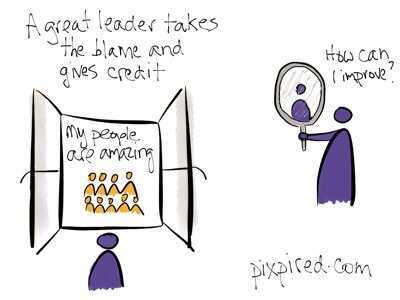
Whenever leaders with excellent character experience failure, they look at the mirror and ask themselves what they could have done differently. On the other hand, when there are successes, they look out the window, away from themselves, and they look for the people deserving of credit.
It’s introspection when things go wrong, and self-denial when things go right. A great leader balances both noble humility and fierce resolve.
The Leader Character Framework
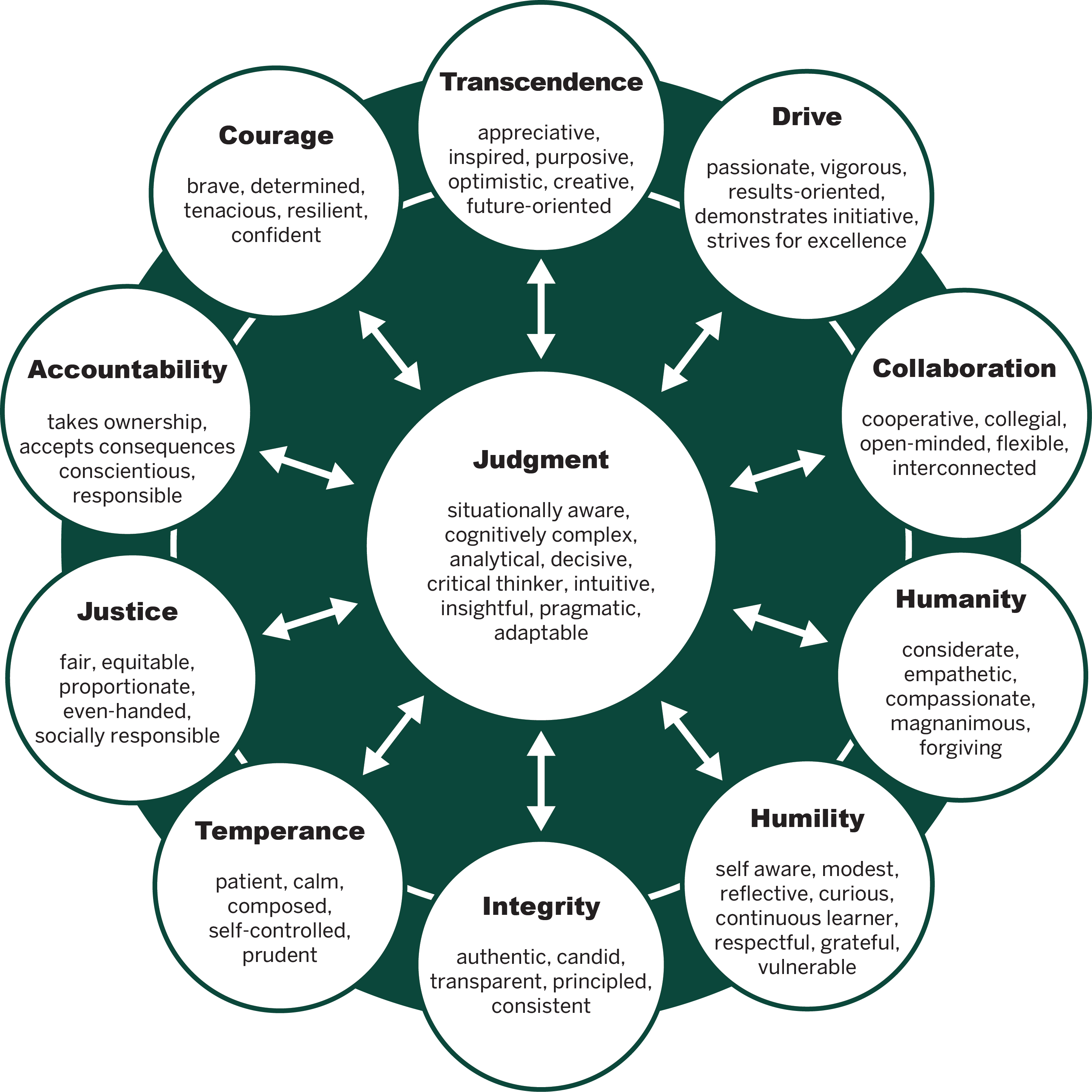
In 2014, a group of researchers from the Ivey Business School sought to determine leadership mistakes and other possible factors that led to the 2007-2008 global financial crisis. In the end, the research team developed a framework which they called The Leader Character Framework. It revealed that the biggest failure that resulted in the financial crisis had much to do with character.
They ultimately defined character as a combination of traits, values, and virtues. The framework suggests that true character comes from exercising and balancing all elements or “dimensions,” which they say are non-negotiable. The point is that you cannot be lacking in one and expect that to be compensated by another. At the same time, the framework states that having too much or too little of one element ends in a virtue turning into a vice.
Simply put, you can’t have one set of values without the rest of the others. You have to have all of it at once.
For example, when you have a leader full of drive and courage but only a minimal sense of humanity, they’re most likely going to make decisions that only favor their best interests.
If a leader possesses great integrity but not much sense of collaboration and humility, you get someone who’s incredibly dogmatic, who refuses to be convinced of anything, and who doesn’t acknowledge views and opinions but their own.
Leader Character in Practice
In putting character into practice, these are the elements we must learn to possess and balance.
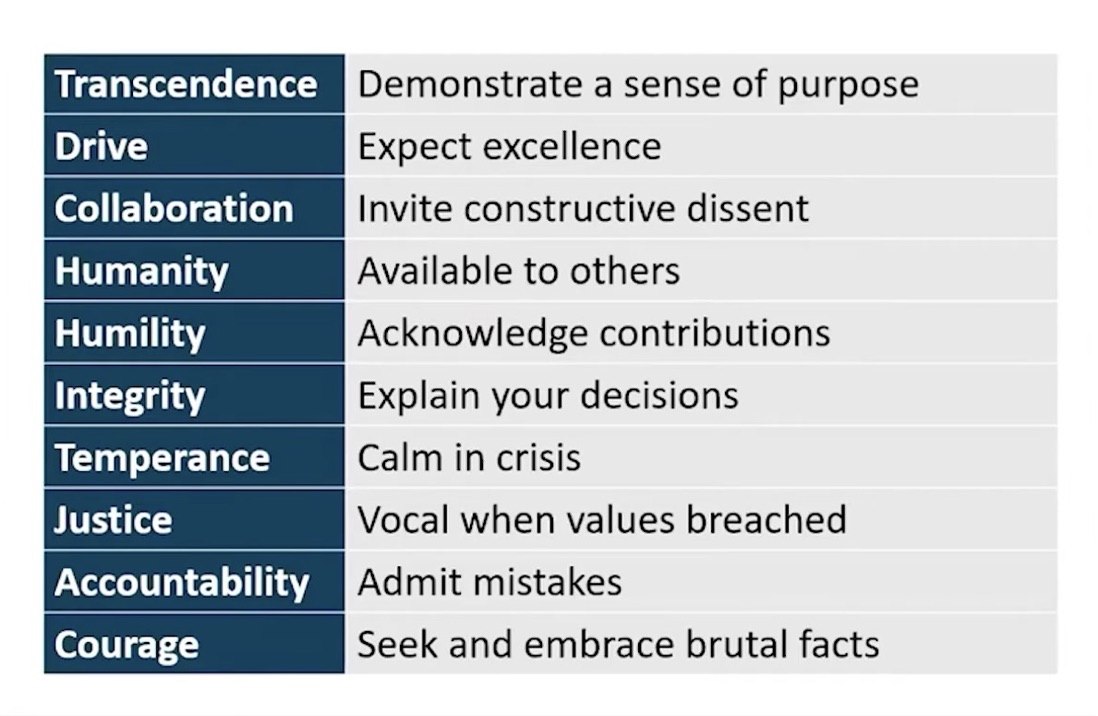
Transcendence
Transcendence essentially means having a clear sense of purpose. Is the “why” behind your organization clear to you and your team? Sometimes, it’s easy to get too caught up with executing business plans and conducting transactions that we forget the broader mission set before us. What’s more alarming is that the mission is actually what should inspire everything that we do. And yet, we very often lose sight of it.
If you already are aware of your mission, then instill that in your people. Teach them the value of looking ahead while still not losing their way.
Drive
During anxious times, when everyone appears to be spread too thin, you might think it’s best not to push for excellence. While you do have to be considerate and patient, you still have to aim for high-quality work. Going back to balancing the dimensions, if you’re all about humility and humanity, but you don’t have the motivation to press on despite disruptions, you and your team will never progress. Even in the middle of crises, people still want to progress. Therefore, your job as a leader is to communicate and partner with them on figuring out ways to collectively advance toward the organization’s goals without leaving anyone behind.
Collaboration
We all know that collaboration means maintaining positive relationships and working toward a common goal. But collaboration also means allowing for open dialogue and constructive dissent. Understand that in any team environment, there are always people with opinions different from yours. For collaboration to happen, you have to establish a safe place for every voice to be heard and for people to disagree constructively.
Humanity
In times of distress, people need people to go through life with. What exactly does it mean to lead with humanity? Humanity simply means being available. It means letting your people know that you’re there for them—not only for the business side of things and not just as an authority figure, but as a person.
Humility
Holding a leadership position can quickly get to someone’s head. But leaders with exemplary character do not count themselves as superior or more special than their people, even though they might hold a title that assumes they’re technically above others. Again, it’s about looking out the window and acknowledging people’s accomplishments, no matter how big or how small. Sometimes, humility even means deflecting all the praise of success from yourself to them.
Integrity
Like we have already established, integrity shouldn’t just mean having a high moral standard or possessing a firm, dogmatic adherence to your personal beliefs. Integrity is also equal to transparently walking people through the rationale behind every decision that’s being made and allowing others to challenge your assumptions. It might sound challenging, but this will help you grow as a leader. Letting people point out the possible flaws of your decision-making will enable yourself to learn and develop.
Temperance
Temperance is the ability to remain calm and composed despite tense situations. It means being able to think clearly and reasonably even in the face of crisis.
We face troubles every day. Some of them might only be temporary, but they still require thoughtful solving. For instance, if someone sent out the wrong email. From a micro perspective, that’s still a crisis. But temperance is being able to remain calm despite anything that may arise, large or small. Not that you wouldn’t have to do anything to set wrongs right, but it only means you are capable of rationality even when it seems impossible.
Justice
True character leaders take action when they see values being breached. You could steer clear of conflicts in an attempt to be indifferent, but your leadership is demonstrated by what you say as much as what you don’t say. Remember, you’re leading people. The team’s best interest is your best interest.
Accountability
Accountability is owning up to your mistakes. It means being vulnerable enough to let your people know of your shortcomings, not to shame yourself, but to consider them as learning opportunities for yourself and for others.
Courage
Finally, character requires courage to admit that you don’t have all the answers, courage to accept the reality of this volatile, uncertain, complex, and ambiguous world, and courage to confront every difficulty head-on—because the only way to move past a challenge is to face it.
These are what make a leader with character. As we continue to tread these volatile waters we find ourselves in, let’s begin building on our character for the betterment of both ourselves and our people. Remember to stay standing between your mirror and your window.
All things considered, how do we effectively apply these to our leadership if we’re constrained to interacting through screens? How do we communicate character in a virtual world?
We do it through video.
Communicating in a Virtual World

Out of all the available mediums today, video is the closest you can get to interacting with your team in person. With Dubb, you have the tools you need to create videos that display your leadership.
Dubb is a video messaging platform that is mainly used for marketing and prospecting efforts. But that’s not all of it. Being a business leader, it’s critical to regularly communicate with your team for day-to-day updates, meetings, and other relevant matters. Now, you could write those out as regular emails, but there wouldn’t be much of an authentic connection.
Many companies use Dubb for communicating internally with their teams. It’s efficient, engaging, and convenient. If you aspire to do the same, then you’re in the right place.
Let’s go over a brief introduction of Dubb’s features that you can use to send quality videos to your people.
Video Creation
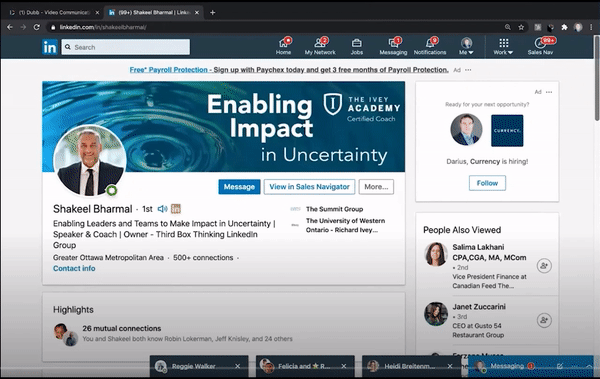
The Dubb Chrome Extension tool provides you one-click access to several video recording options. You can record your entire screen (or a portion of your screen) and include a webcam video of yourself down on the corner. If you already have a video from your library or YouTube, you can upload that to Dubb as well.
Using the Dubb mobile app, you have access to real-time video editing features—you can shoot short bursts of clips and simultaneously splice them together. If you’re thinking of sending a conversational video to your team, you can record one through the mobile app and personalize it with text, emojis, and music. The mobile app is available for both iOS and Android.

As if these weren’t functional enough, you can access all of Dubb’s features directly from LinkedIn, Gmail, Outlook, and various other email and CRM platforms. How? Dubb has direct integration with several messaging platforms. Even if the platform you’re using doesn’t have direct integration, you can still use the Chrome Extension to record videos from whichever tab you have opened.
Video Customization
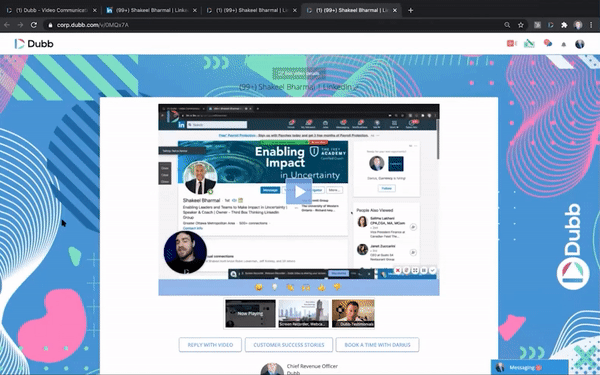
After creating your video, it’s time to package it up. Upon uploading your video, Dubb automatically builds a landing page for it—complete with company logo, watermark, colors, and even a custom background image. Unlike YouTube, you wouldn’t find distractions like other brands and advertisements on Dubb’s video landing page. It’s just you, your brand, and your video.
If you wish to send out multiple videos at once, you can use the video playlist feature. Just pick a set of videos in order, upload them, and each one automatically plays once the previous video is over. This way, if you’re thinking of sharing a combination of spontaneously recorded and pre-produced videos, you can do so without your recipients having to click on separate links to watch each one.
Whenever creating videos, there’s always the ultimate intention of encouraging your viewers to take action. With Dubb’s fully customizable call-to-action (“CTA”) buttons, you can do just that. CTAs are devices for encouraging your viewers to engage with your message; you can create the buttons so that they offer the option to book an appointment with you, fill out a form, download an attachment, or even for your viewers to shoot and send a video of their own without having to install anything—nearly every action you could think of, you can customize the CTAs to become it.

Aside from the CTAs, there’s also the exit intent pop-up that prompts your recipients to take one last action before leaving the page.
Need to send out a ton of videos for different use cases? You can build custom video presets. They instantly change the page elements from the video content, CTA buttons, colors, and everything else for maximum personalization and better engagement from your viewers. Once they see that your videos were made specifically for them, they would indeed be inclined to click.
Video Distribution
When it comes to distribution, you have even more opportunities to capture your recipients’ attention. For example, if you send your videos out via LinkedIn, the thumbnail will appear as an animated GIF preview of the first few seconds. And you can do this directly from LinkedIn and many other platforms—look for the Dubb icon, click, and that gives you access to your video library, video recorder, and the rest of Dubb’s features, straight from the channel you’re using.
Aside from sending through direct integration, there’s also the option to share your videos universally. Dubb’s share and send feature allows you to copy and paste your videos into any channel you’re using while still being able to lead them to the landing page and track your videos’ performance.
Should you need to schedule sending your videos via email, you can use Dubb’s campaign feature. With campaigns, you can distribute messages one-to-one or one-to-many automatically. These are sent through your email, so all you have to do is link your email provider to Dubb, and you can let Dubb do the sending on your behalf.
The other option is automation, which automatically sends out dynamic messages to your contacts, depending on the rules you’ve set up. You can build your automation workflows as complicated or straightforward as you wish them to be. It’s entirely up to you.
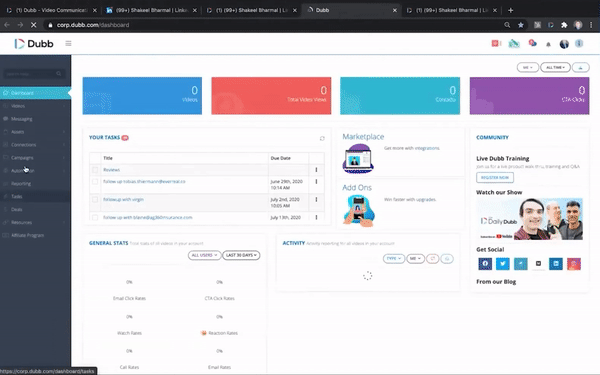
Regardless of where and how you send your Dubb videos, you will be able to track its analytics—who watched your videos, what percentage they watched, whether they clicked on your CTAs, and practically every bit of engagement that your videos get, which are particularly helpful for letting you know how you can communicate better.

Making Leadership Happen Amid Disruption
Leading in an age of disruption is no easy task. But it doesn’t matter whether we’re working from home or collaborating up close. We must move forward. And you, as a leader, can make that happen.
Dubb was developed for team success. Sign up for a free Dubb account today and see how you can lead and manage your people with actionable, trackable, and valuable videos.

